International Economics Report: HES, SPS, and Exchange Rates
VerifiedAdded on 2022/09/16
|19
|4342
|25
Report
AI Summary
This report on international economics delves into key aspects of global trade and economic policies. It examines the significance of Health, Environment, and Safety (HES) and Sanitary and Phytosanitary (SPS) standards within international trade, highlighting their role as potential trade barriers and their impact on developing countries. The report further analyzes the economic growth of China and Japan, comparing their GDP trends and the factors influencing their economic performance, including exchange rate policies and trade dynamics. It also explores import substitution and export promotion strategies, illustrating their application with a case study of Singapore's export-oriented economy and its monetary policy, particularly the use of exchange rate control by the Monetary Authority of Singapore (MAS). The report utilizes figures to illustrate economic trends and provides insights into the complexities of international economic relationships, trade policies, and monetary management.
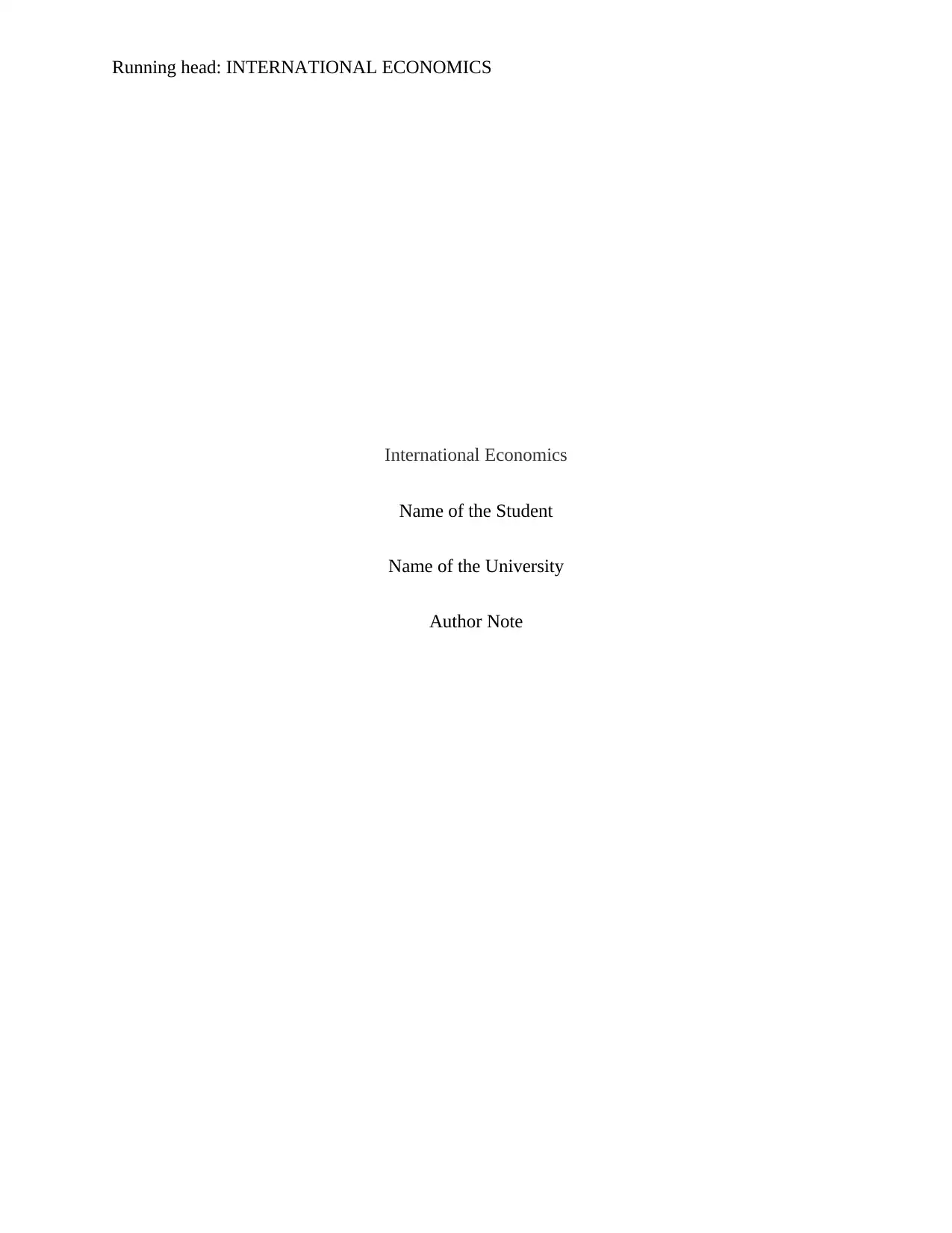
Running head: INTERNATIONAL ECONOMICS
International Economics
Name of the Student
Name of the University
Author Note
International Economics
Name of the Student
Name of the University
Author Note
Paraphrase This Document
Need a fresh take? Get an instant paraphrase of this document with our AI Paraphraser
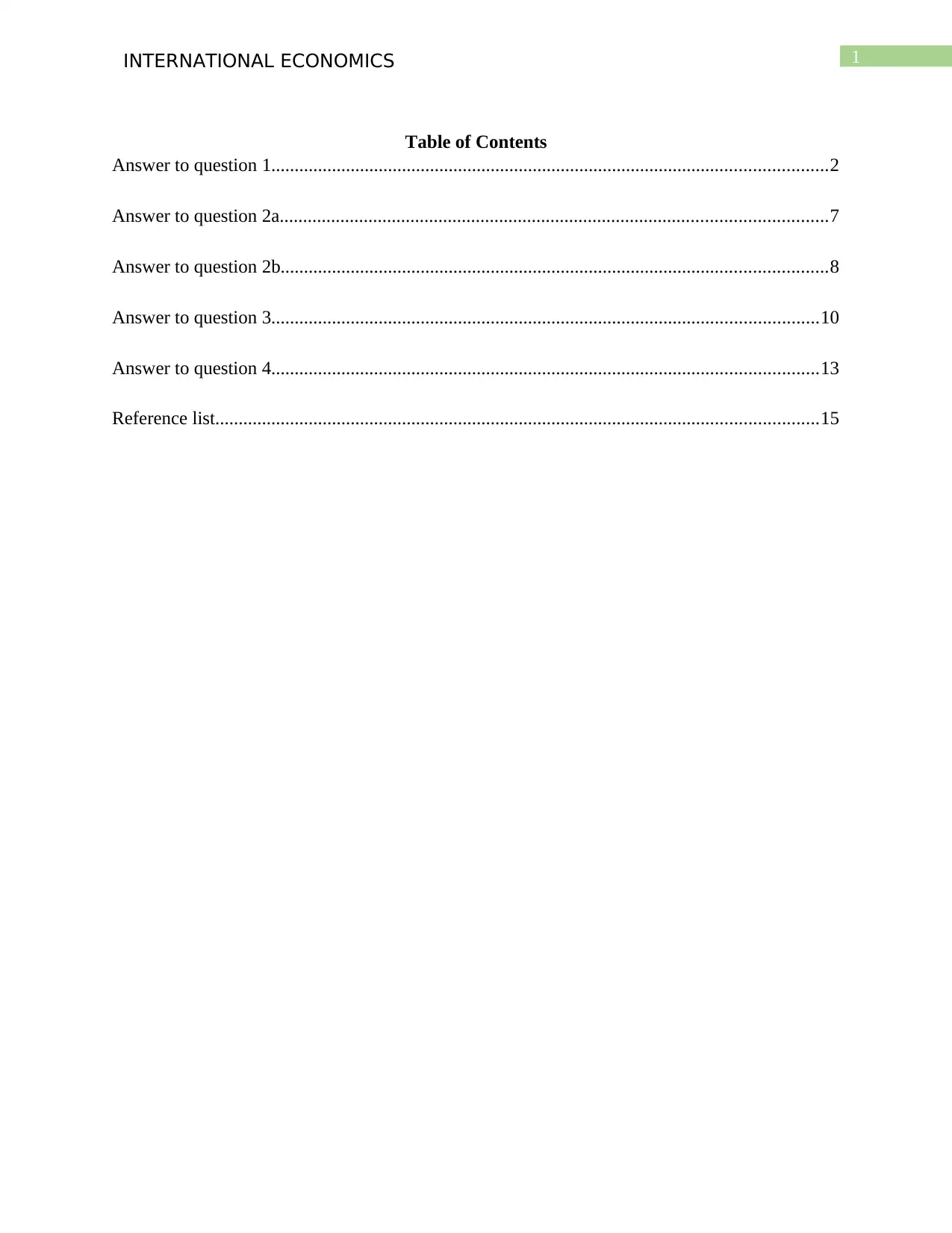
1INTERNATIONAL ECONOMICS
Table of Contents
Answer to question 1.......................................................................................................................2
Answer to question 2a.....................................................................................................................7
Answer to question 2b.....................................................................................................................8
Answer to question 3.....................................................................................................................10
Answer to question 4.....................................................................................................................13
Reference list.................................................................................................................................15
Table of Contents
Answer to question 1.......................................................................................................................2
Answer to question 2a.....................................................................................................................7
Answer to question 2b.....................................................................................................................8
Answer to question 3.....................................................................................................................10
Answer to question 4.....................................................................................................................13
Reference list.................................................................................................................................15
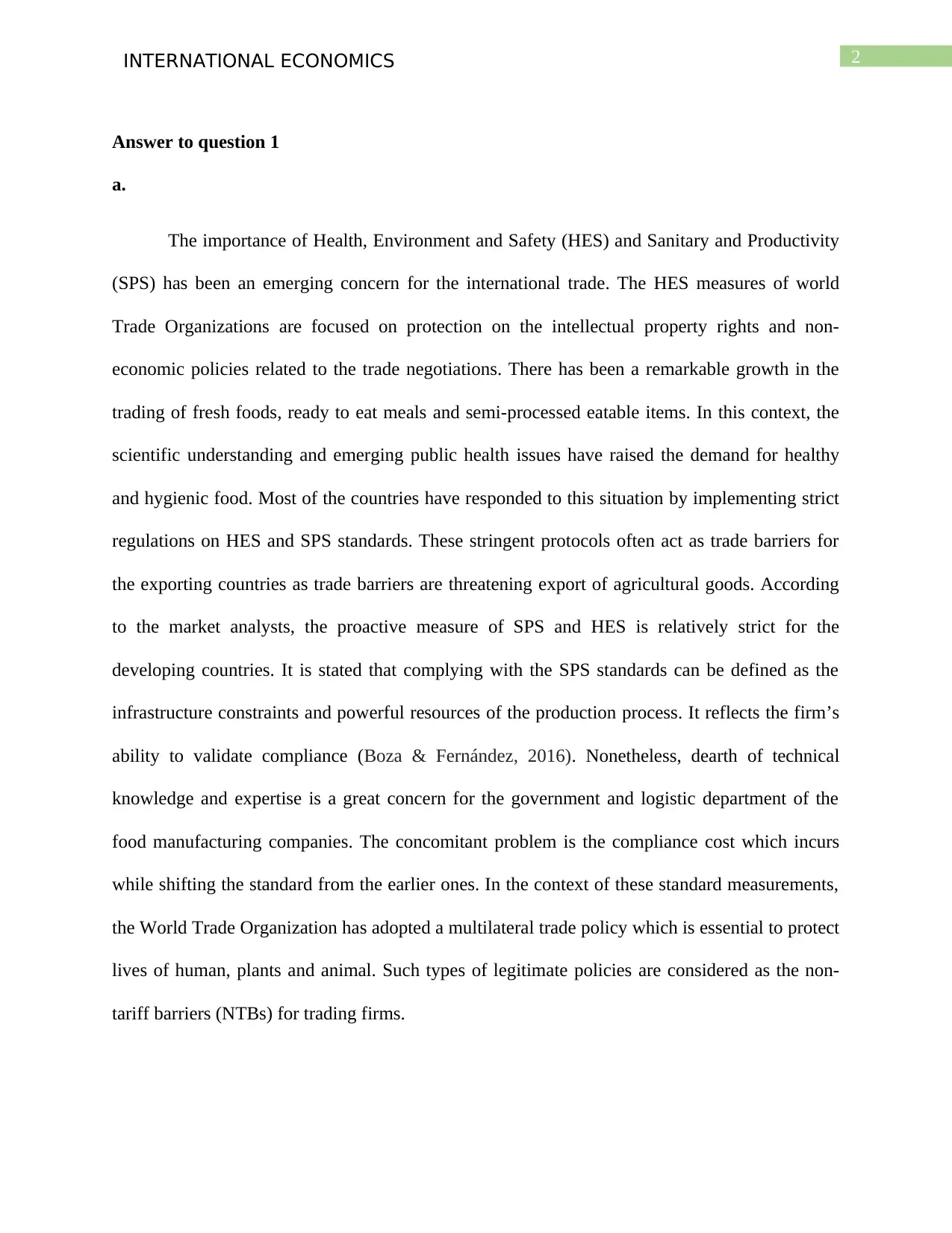
2INTERNATIONAL ECONOMICS
Answer to question 1
a.
The importance of Health, Environment and Safety (HES) and Sanitary and Productivity
(SPS) has been an emerging concern for the international trade. The HES measures of world
Trade Organizations are focused on protection on the intellectual property rights and non-
economic policies related to the trade negotiations. There has been a remarkable growth in the
trading of fresh foods, ready to eat meals and semi-processed eatable items. In this context, the
scientific understanding and emerging public health issues have raised the demand for healthy
and hygienic food. Most of the countries have responded to this situation by implementing strict
regulations on HES and SPS standards. These stringent protocols often act as trade barriers for
the exporting countries as trade barriers are threatening export of agricultural goods. According
to the market analysts, the proactive measure of SPS and HES is relatively strict for the
developing countries. It is stated that complying with the SPS standards can be defined as the
infrastructure constraints and powerful resources of the production process. It reflects the firm’s
ability to validate compliance (Boza & Fernández, 2016). Nonetheless, dearth of technical
knowledge and expertise is a great concern for the government and logistic department of the
food manufacturing companies. The concomitant problem is the compliance cost which incurs
while shifting the standard from the earlier ones. In the context of these standard measurements,
the World Trade Organization has adopted a multilateral trade policy which is essential to protect
lives of human, plants and animal. Such types of legitimate policies are considered as the non-
tariff barriers (NTBs) for trading firms.
Answer to question 1
a.
The importance of Health, Environment and Safety (HES) and Sanitary and Productivity
(SPS) has been an emerging concern for the international trade. The HES measures of world
Trade Organizations are focused on protection on the intellectual property rights and non-
economic policies related to the trade negotiations. There has been a remarkable growth in the
trading of fresh foods, ready to eat meals and semi-processed eatable items. In this context, the
scientific understanding and emerging public health issues have raised the demand for healthy
and hygienic food. Most of the countries have responded to this situation by implementing strict
regulations on HES and SPS standards. These stringent protocols often act as trade barriers for
the exporting countries as trade barriers are threatening export of agricultural goods. According
to the market analysts, the proactive measure of SPS and HES is relatively strict for the
developing countries. It is stated that complying with the SPS standards can be defined as the
infrastructure constraints and powerful resources of the production process. It reflects the firm’s
ability to validate compliance (Boza & Fernández, 2016). Nonetheless, dearth of technical
knowledge and expertise is a great concern for the government and logistic department of the
food manufacturing companies. The concomitant problem is the compliance cost which incurs
while shifting the standard from the earlier ones. In the context of these standard measurements,
the World Trade Organization has adopted a multilateral trade policy which is essential to protect
lives of human, plants and animal. Such types of legitimate policies are considered as the non-
tariff barriers (NTBs) for trading firms.
⊘ This is a preview!⊘
Do you want full access?
Subscribe today to unlock all pages.

Trusted by 1+ million students worldwide
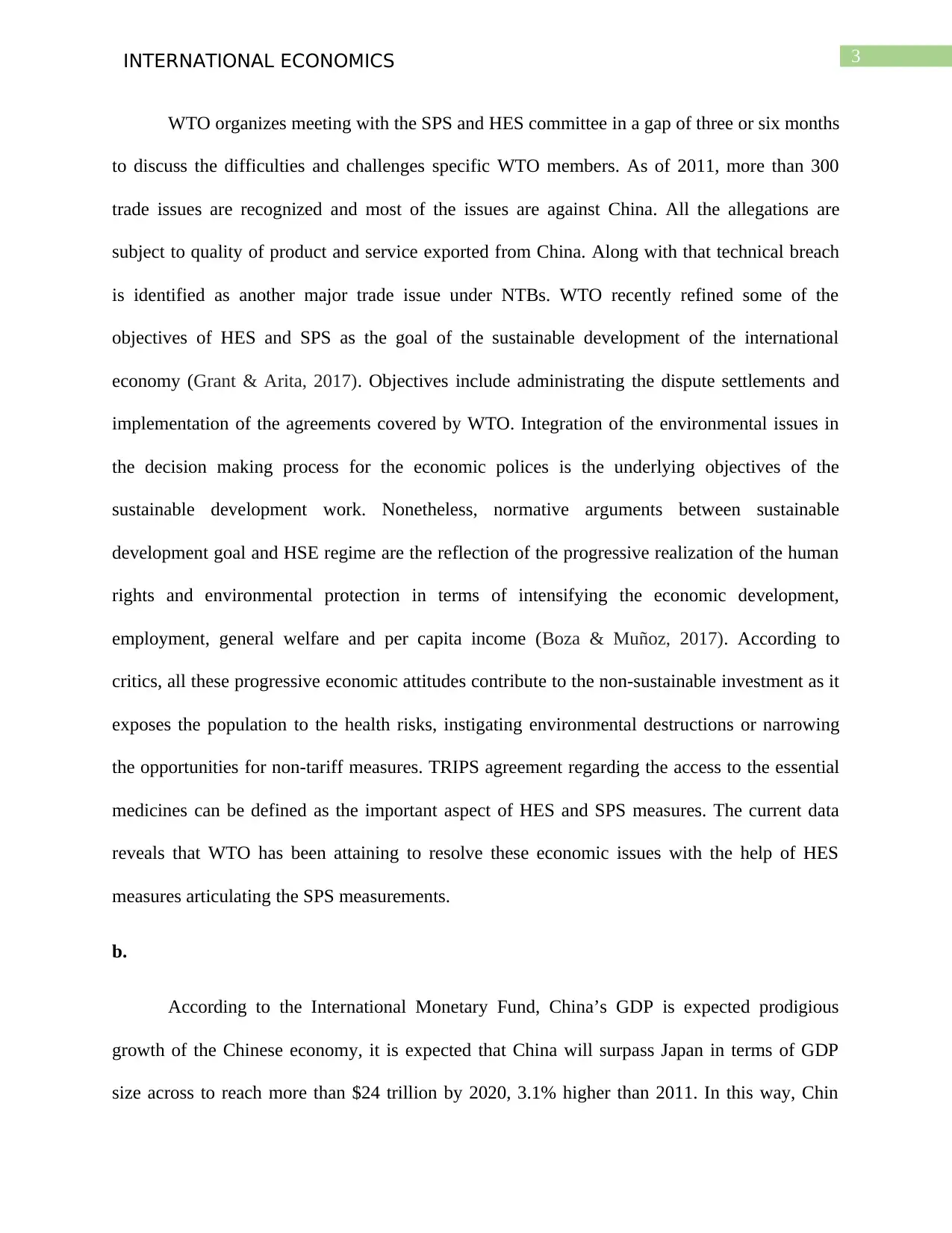
3INTERNATIONAL ECONOMICS
WTO organizes meeting with the SPS and HES committee in a gap of three or six months
to discuss the difficulties and challenges specific WTO members. As of 2011, more than 300
trade issues are recognized and most of the issues are against China. All the allegations are
subject to quality of product and service exported from China. Along with that technical breach
is identified as another major trade issue under NTBs. WTO recently refined some of the
objectives of HES and SPS as the goal of the sustainable development of the international
economy (Grant & Arita, 2017). Objectives include administrating the dispute settlements and
implementation of the agreements covered by WTO. Integration of the environmental issues in
the decision making process for the economic polices is the underlying objectives of the
sustainable development work. Nonetheless, normative arguments between sustainable
development goal and HSE regime are the reflection of the progressive realization of the human
rights and environmental protection in terms of intensifying the economic development,
employment, general welfare and per capita income (Boza & Muñoz, 2017). According to
critics, all these progressive economic attitudes contribute to the non-sustainable investment as it
exposes the population to the health risks, instigating environmental destructions or narrowing
the opportunities for non-tariff measures. TRIPS agreement regarding the access to the essential
medicines can be defined as the important aspect of HES and SPS measures. The current data
reveals that WTO has been attaining to resolve these economic issues with the help of HES
measures articulating the SPS measurements.
b.
According to the International Monetary Fund, China’s GDP is expected prodigious
growth of the Chinese economy, it is expected that China will surpass Japan in terms of GDP
size across to reach more than $24 trillion by 2020, 3.1% higher than 2011. In this way, Chin
WTO organizes meeting with the SPS and HES committee in a gap of three or six months
to discuss the difficulties and challenges specific WTO members. As of 2011, more than 300
trade issues are recognized and most of the issues are against China. All the allegations are
subject to quality of product and service exported from China. Along with that technical breach
is identified as another major trade issue under NTBs. WTO recently refined some of the
objectives of HES and SPS as the goal of the sustainable development of the international
economy (Grant & Arita, 2017). Objectives include administrating the dispute settlements and
implementation of the agreements covered by WTO. Integration of the environmental issues in
the decision making process for the economic polices is the underlying objectives of the
sustainable development work. Nonetheless, normative arguments between sustainable
development goal and HSE regime are the reflection of the progressive realization of the human
rights and environmental protection in terms of intensifying the economic development,
employment, general welfare and per capita income (Boza & Muñoz, 2017). According to
critics, all these progressive economic attitudes contribute to the non-sustainable investment as it
exposes the population to the health risks, instigating environmental destructions or narrowing
the opportunities for non-tariff measures. TRIPS agreement regarding the access to the essential
medicines can be defined as the important aspect of HES and SPS measures. The current data
reveals that WTO has been attaining to resolve these economic issues with the help of HES
measures articulating the SPS measurements.
b.
According to the International Monetary Fund, China’s GDP is expected prodigious
growth of the Chinese economy, it is expected that China will surpass Japan in terms of GDP
size across to reach more than $24 trillion by 2020, 3.1% higher than 2011. In this way, Chin
Paraphrase This Document
Need a fresh take? Get an instant paraphrase of this document with our AI Paraphraser
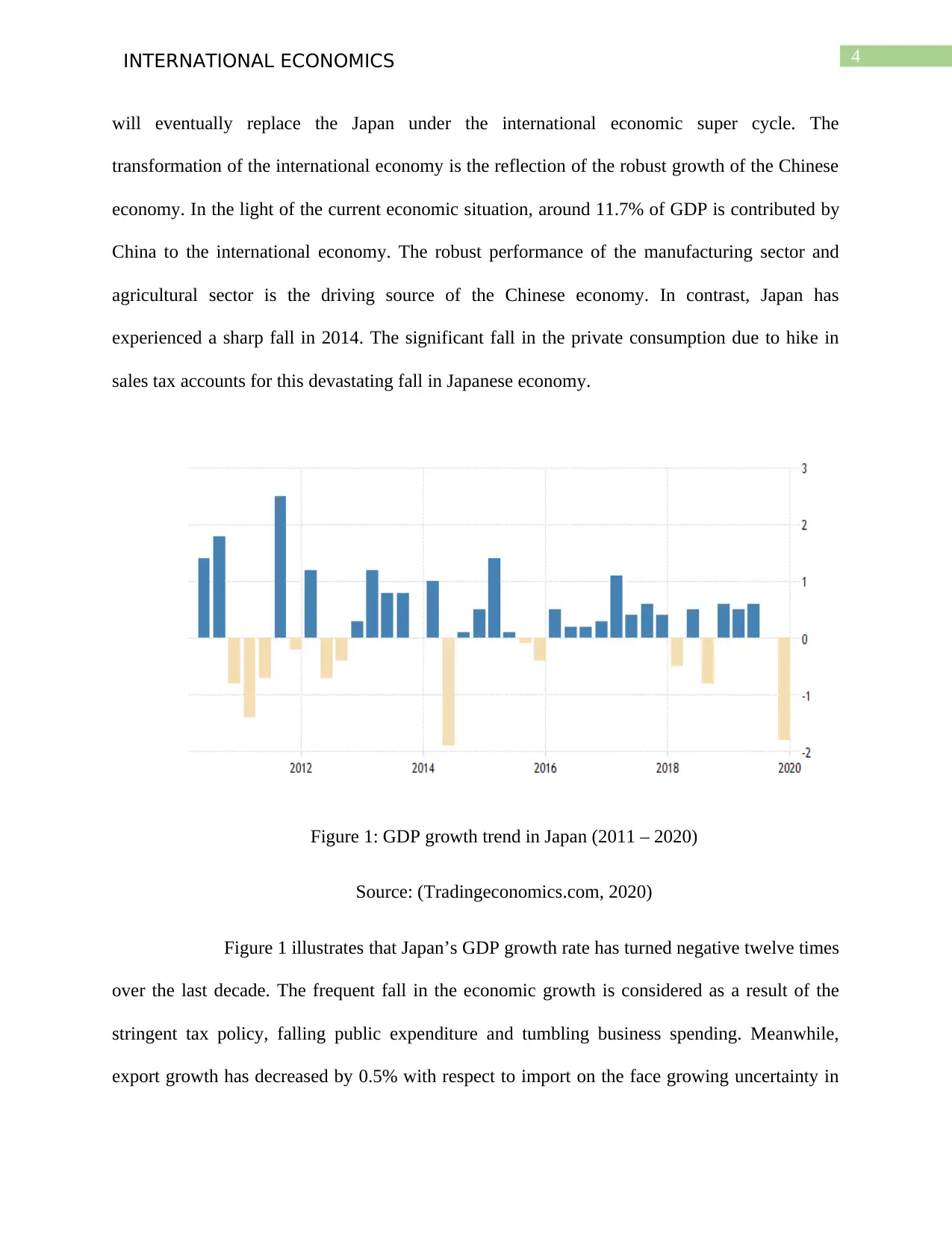
4INTERNATIONAL ECONOMICS
will eventually replace the Japan under the international economic super cycle. The
transformation of the international economy is the reflection of the robust growth of the Chinese
economy. In the light of the current economic situation, around 11.7% of GDP is contributed by
China to the international economy. The robust performance of the manufacturing sector and
agricultural sector is the driving source of the Chinese economy. In contrast, Japan has
experienced a sharp fall in 2014. The significant fall in the private consumption due to hike in
sales tax accounts for this devastating fall in Japanese economy.
Figure 1: GDP growth trend in Japan (2011 – 2020)
Source: (Tradingeconomics.com, 2020)
Figure 1 illustrates that Japan’s GDP growth rate has turned negative twelve times
over the last decade. The frequent fall in the economic growth is considered as a result of the
stringent tax policy, falling public expenditure and tumbling business spending. Meanwhile,
export growth has decreased by 0.5% with respect to import on the face growing uncertainty in
will eventually replace the Japan under the international economic super cycle. The
transformation of the international economy is the reflection of the robust growth of the Chinese
economy. In the light of the current economic situation, around 11.7% of GDP is contributed by
China to the international economy. The robust performance of the manufacturing sector and
agricultural sector is the driving source of the Chinese economy. In contrast, Japan has
experienced a sharp fall in 2014. The significant fall in the private consumption due to hike in
sales tax accounts for this devastating fall in Japanese economy.
Figure 1: GDP growth trend in Japan (2011 – 2020)
Source: (Tradingeconomics.com, 2020)
Figure 1 illustrates that Japan’s GDP growth rate has turned negative twelve times
over the last decade. The frequent fall in the economic growth is considered as a result of the
stringent tax policy, falling public expenditure and tumbling business spending. Meanwhile,
export growth has decreased by 0.5% with respect to import on the face growing uncertainty in
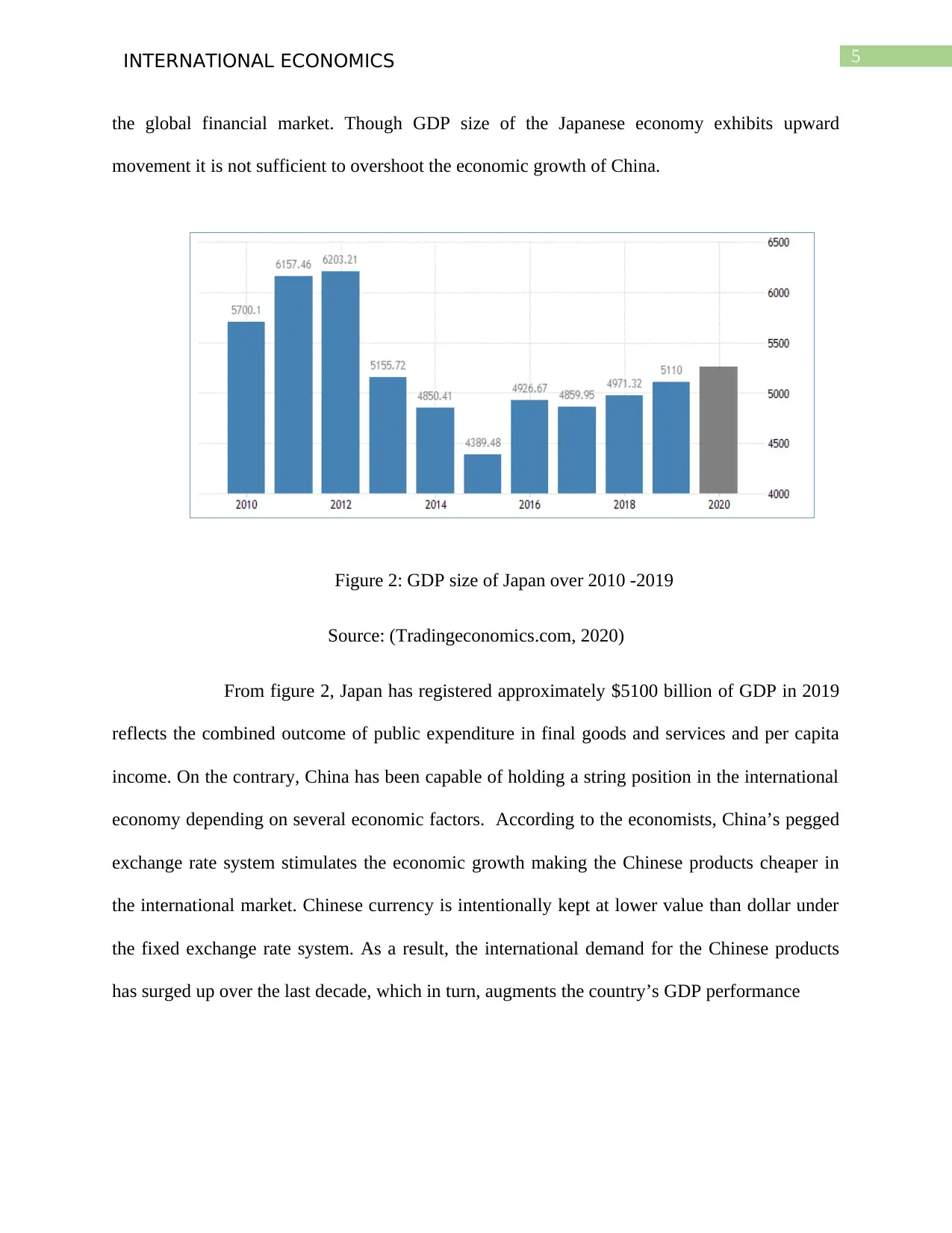
5INTERNATIONAL ECONOMICS
the global financial market. Though GDP size of the Japanese economy exhibits upward
movement it is not sufficient to overshoot the economic growth of China.
Figure 2: GDP size of Japan over 2010 -2019
Source: (Tradingeconomics.com, 2020)
From figure 2, Japan has registered approximately $5100 billion of GDP in 2019
reflects the combined outcome of public expenditure in final goods and services and per capita
income. On the contrary, China has been capable of holding a string position in the international
economy depending on several economic factors. According to the economists, China’s pegged
exchange rate system stimulates the economic growth making the Chinese products cheaper in
the international market. Chinese currency is intentionally kept at lower value than dollar under
the fixed exchange rate system. As a result, the international demand for the Chinese products
has surged up over the last decade, which in turn, augments the country’s GDP performance
the global financial market. Though GDP size of the Japanese economy exhibits upward
movement it is not sufficient to overshoot the economic growth of China.
Figure 2: GDP size of Japan over 2010 -2019
Source: (Tradingeconomics.com, 2020)
From figure 2, Japan has registered approximately $5100 billion of GDP in 2019
reflects the combined outcome of public expenditure in final goods and services and per capita
income. On the contrary, China has been capable of holding a string position in the international
economy depending on several economic factors. According to the economists, China’s pegged
exchange rate system stimulates the economic growth making the Chinese products cheaper in
the international market. Chinese currency is intentionally kept at lower value than dollar under
the fixed exchange rate system. As a result, the international demand for the Chinese products
has surged up over the last decade, which in turn, augments the country’s GDP performance
⊘ This is a preview!⊘
Do you want full access?
Subscribe today to unlock all pages.

Trusted by 1+ million students worldwide
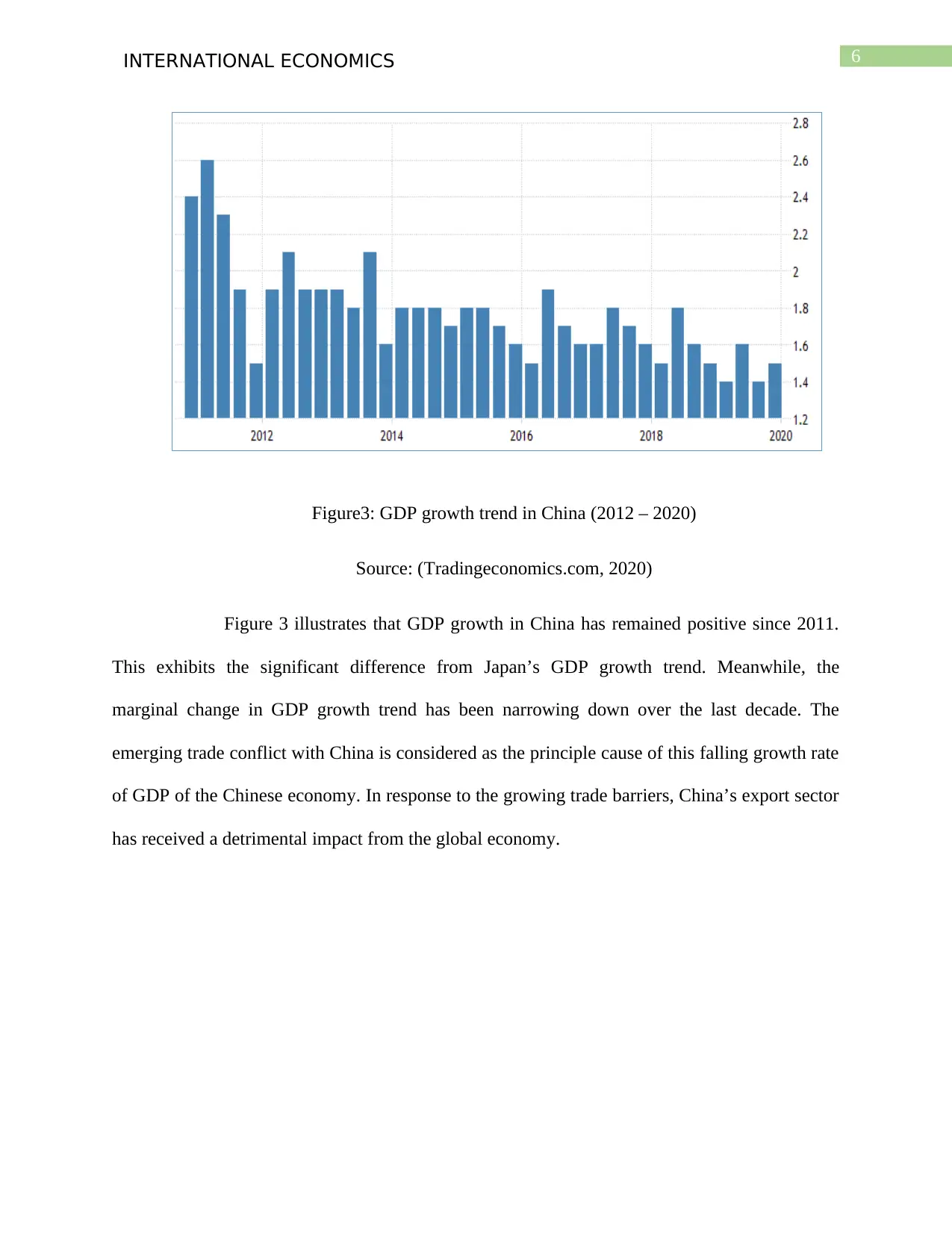
6INTERNATIONAL ECONOMICS
Figure3: GDP growth trend in China (2012 – 2020)
Source: (Tradingeconomics.com, 2020)
Figure 3 illustrates that GDP growth in China has remained positive since 2011.
This exhibits the significant difference from Japan’s GDP growth trend. Meanwhile, the
marginal change in GDP growth trend has been narrowing down over the last decade. The
emerging trade conflict with China is considered as the principle cause of this falling growth rate
of GDP of the Chinese economy. In response to the growing trade barriers, China’s export sector
has received a detrimental impact from the global economy.
Figure3: GDP growth trend in China (2012 – 2020)
Source: (Tradingeconomics.com, 2020)
Figure 3 illustrates that GDP growth in China has remained positive since 2011.
This exhibits the significant difference from Japan’s GDP growth trend. Meanwhile, the
marginal change in GDP growth trend has been narrowing down over the last decade. The
emerging trade conflict with China is considered as the principle cause of this falling growth rate
of GDP of the Chinese economy. In response to the growing trade barriers, China’s export sector
has received a detrimental impact from the global economy.
Paraphrase This Document
Need a fresh take? Get an instant paraphrase of this document with our AI Paraphraser
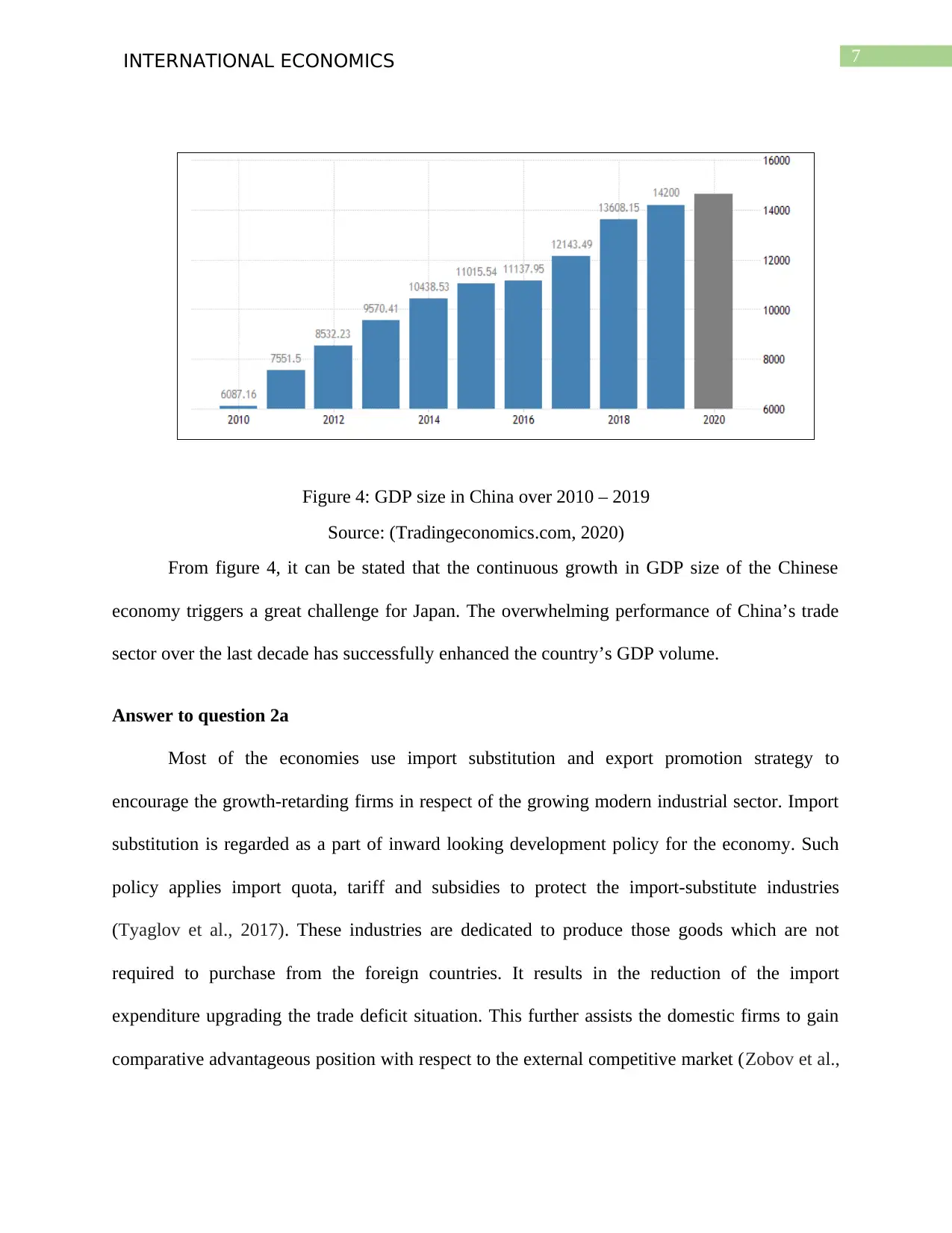
7INTERNATIONAL ECONOMICS
Figure 4: GDP size in China over 2010 – 2019
Source: (Tradingeconomics.com, 2020)
From figure 4, it can be stated that the continuous growth in GDP size of the Chinese
economy triggers a great challenge for Japan. The overwhelming performance of China’s trade
sector over the last decade has successfully enhanced the country’s GDP volume.
Answer to question 2a
Most of the economies use import substitution and export promotion strategy to
encourage the growth-retarding firms in respect of the growing modern industrial sector. Import
substitution is regarded as a part of inward looking development policy for the economy. Such
policy applies import quota, tariff and subsidies to protect the import-substitute industries
(Tyaglov et al., 2017). These industries are dedicated to produce those goods which are not
required to purchase from the foreign countries. It results in the reduction of the import
expenditure upgrading the trade deficit situation. This further assists the domestic firms to gain
comparative advantageous position with respect to the external competitive market (Zobov et al.,
Figure 4: GDP size in China over 2010 – 2019
Source: (Tradingeconomics.com, 2020)
From figure 4, it can be stated that the continuous growth in GDP size of the Chinese
economy triggers a great challenge for Japan. The overwhelming performance of China’s trade
sector over the last decade has successfully enhanced the country’s GDP volume.
Answer to question 2a
Most of the economies use import substitution and export promotion strategy to
encourage the growth-retarding firms in respect of the growing modern industrial sector. Import
substitution is regarded as a part of inward looking development policy for the economy. Such
policy applies import quota, tariff and subsidies to protect the import-substitute industries
(Tyaglov et al., 2017). These industries are dedicated to produce those goods which are not
required to purchase from the foreign countries. It results in the reduction of the import
expenditure upgrading the trade deficit situation. This further assists the domestic firms to gain
comparative advantageous position with respect to the external competitive market (Zobov et al.,
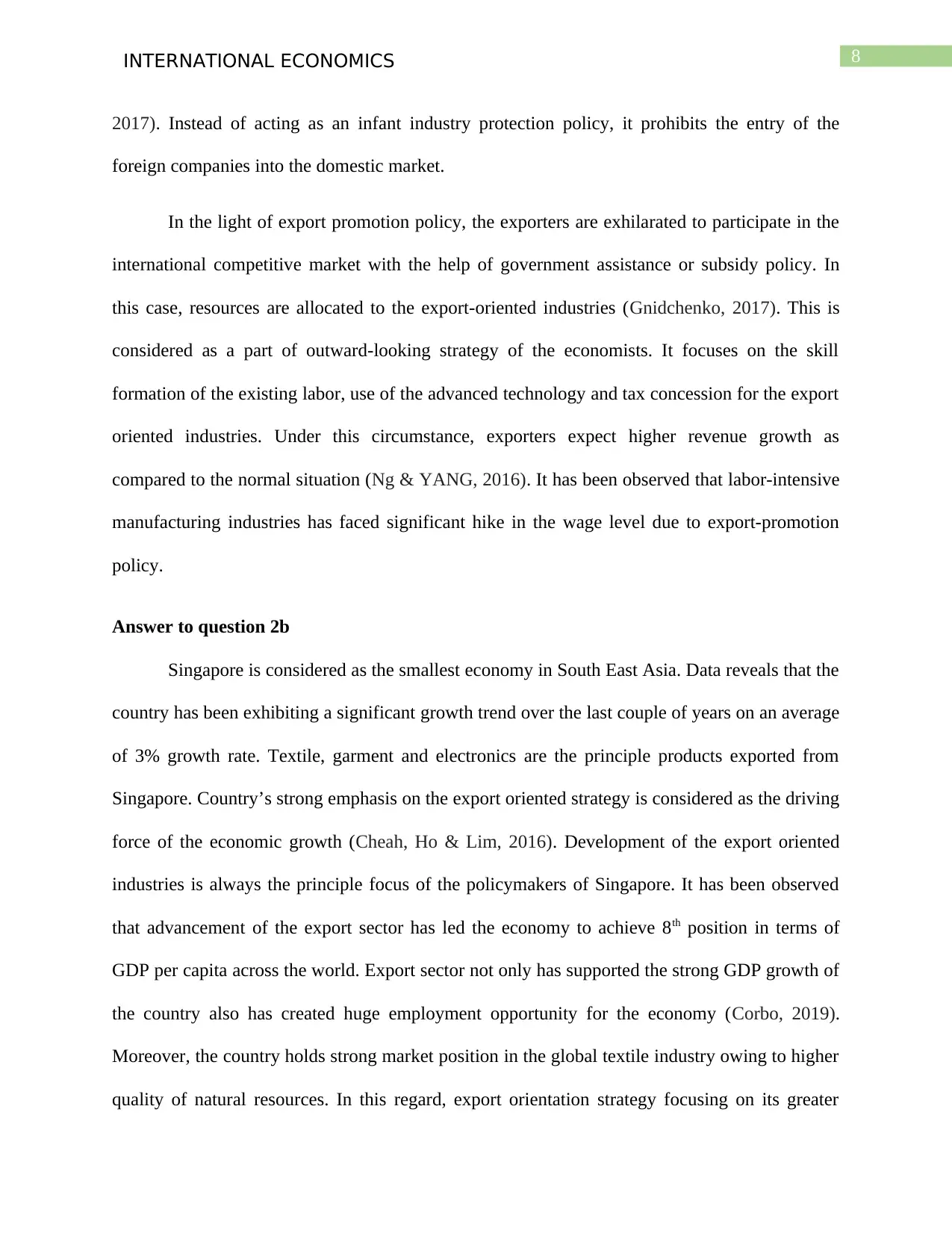
8INTERNATIONAL ECONOMICS
2017). Instead of acting as an infant industry protection policy, it prohibits the entry of the
foreign companies into the domestic market.
In the light of export promotion policy, the exporters are exhilarated to participate in the
international competitive market with the help of government assistance or subsidy policy. In
this case, resources are allocated to the export-oriented industries (Gnidchenko, 2017). This is
considered as a part of outward-looking strategy of the economists. It focuses on the skill
formation of the existing labor, use of the advanced technology and tax concession for the export
oriented industries. Under this circumstance, exporters expect higher revenue growth as
compared to the normal situation (Ng & YANG, 2016). It has been observed that labor-intensive
manufacturing industries has faced significant hike in the wage level due to export-promotion
policy.
Answer to question 2b
Singapore is considered as the smallest economy in South East Asia. Data reveals that the
country has been exhibiting a significant growth trend over the last couple of years on an average
of 3% growth rate. Textile, garment and electronics are the principle products exported from
Singapore. Country’s strong emphasis on the export oriented strategy is considered as the driving
force of the economic growth (Cheah, Ho & Lim, 2016). Development of the export oriented
industries is always the principle focus of the policymakers of Singapore. It has been observed
that advancement of the export sector has led the economy to achieve 8th position in terms of
GDP per capita across the world. Export sector not only has supported the strong GDP growth of
the country also has created huge employment opportunity for the economy (Corbo, 2019).
Moreover, the country holds strong market position in the global textile industry owing to higher
quality of natural resources. In this regard, export orientation strategy focusing on its greater
2017). Instead of acting as an infant industry protection policy, it prohibits the entry of the
foreign companies into the domestic market.
In the light of export promotion policy, the exporters are exhilarated to participate in the
international competitive market with the help of government assistance or subsidy policy. In
this case, resources are allocated to the export-oriented industries (Gnidchenko, 2017). This is
considered as a part of outward-looking strategy of the economists. It focuses on the skill
formation of the existing labor, use of the advanced technology and tax concession for the export
oriented industries. Under this circumstance, exporters expect higher revenue growth as
compared to the normal situation (Ng & YANG, 2016). It has been observed that labor-intensive
manufacturing industries has faced significant hike in the wage level due to export-promotion
policy.
Answer to question 2b
Singapore is considered as the smallest economy in South East Asia. Data reveals that the
country has been exhibiting a significant growth trend over the last couple of years on an average
of 3% growth rate. Textile, garment and electronics are the principle products exported from
Singapore. Country’s strong emphasis on the export oriented strategy is considered as the driving
force of the economic growth (Cheah, Ho & Lim, 2016). Development of the export oriented
industries is always the principle focus of the policymakers of Singapore. It has been observed
that advancement of the export sector has led the economy to achieve 8th position in terms of
GDP per capita across the world. Export sector not only has supported the strong GDP growth of
the country also has created huge employment opportunity for the economy (Corbo, 2019).
Moreover, the country holds strong market position in the global textile industry owing to higher
quality of natural resources. In this regard, export orientation strategy focusing on its greater
⊘ This is a preview!⊘
Do you want full access?
Subscribe today to unlock all pages.

Trusted by 1+ million students worldwide
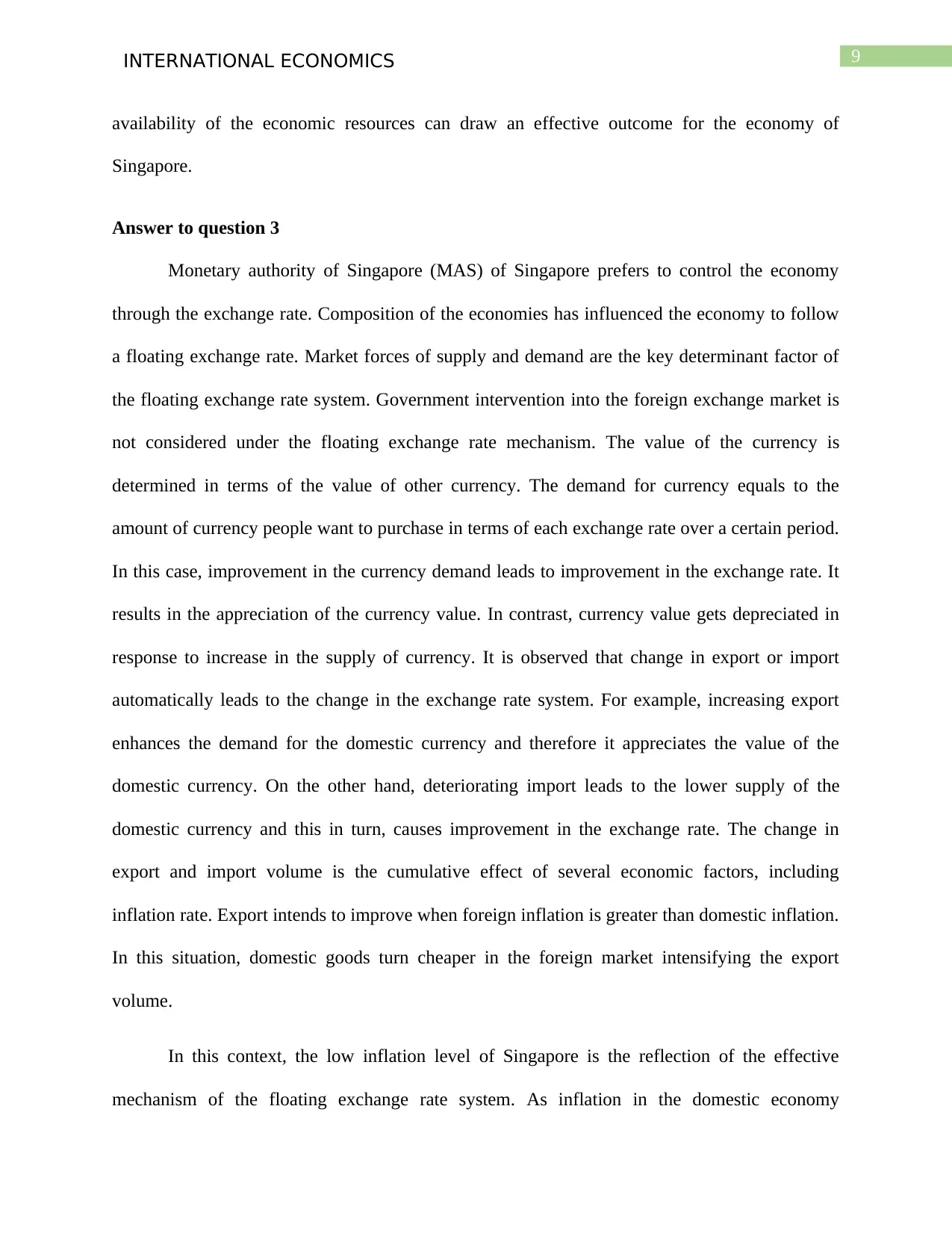
9INTERNATIONAL ECONOMICS
availability of the economic resources can draw an effective outcome for the economy of
Singapore.
Answer to question 3
Monetary authority of Singapore (MAS) of Singapore prefers to control the economy
through the exchange rate. Composition of the economies has influenced the economy to follow
a floating exchange rate. Market forces of supply and demand are the key determinant factor of
the floating exchange rate system. Government intervention into the foreign exchange market is
not considered under the floating exchange rate mechanism. The value of the currency is
determined in terms of the value of other currency. The demand for currency equals to the
amount of currency people want to purchase in terms of each exchange rate over a certain period.
In this case, improvement in the currency demand leads to improvement in the exchange rate. It
results in the appreciation of the currency value. In contrast, currency value gets depreciated in
response to increase in the supply of currency. It is observed that change in export or import
automatically leads to the change in the exchange rate system. For example, increasing export
enhances the demand for the domestic currency and therefore it appreciates the value of the
domestic currency. On the other hand, deteriorating import leads to the lower supply of the
domestic currency and this in turn, causes improvement in the exchange rate. The change in
export and import volume is the cumulative effect of several economic factors, including
inflation rate. Export intends to improve when foreign inflation is greater than domestic inflation.
In this situation, domestic goods turn cheaper in the foreign market intensifying the export
volume.
In this context, the low inflation level of Singapore is the reflection of the effective
mechanism of the floating exchange rate system. As inflation in the domestic economy
availability of the economic resources can draw an effective outcome for the economy of
Singapore.
Answer to question 3
Monetary authority of Singapore (MAS) of Singapore prefers to control the economy
through the exchange rate. Composition of the economies has influenced the economy to follow
a floating exchange rate. Market forces of supply and demand are the key determinant factor of
the floating exchange rate system. Government intervention into the foreign exchange market is
not considered under the floating exchange rate mechanism. The value of the currency is
determined in terms of the value of other currency. The demand for currency equals to the
amount of currency people want to purchase in terms of each exchange rate over a certain period.
In this case, improvement in the currency demand leads to improvement in the exchange rate. It
results in the appreciation of the currency value. In contrast, currency value gets depreciated in
response to increase in the supply of currency. It is observed that change in export or import
automatically leads to the change in the exchange rate system. For example, increasing export
enhances the demand for the domestic currency and therefore it appreciates the value of the
domestic currency. On the other hand, deteriorating import leads to the lower supply of the
domestic currency and this in turn, causes improvement in the exchange rate. The change in
export and import volume is the cumulative effect of several economic factors, including
inflation rate. Export intends to improve when foreign inflation is greater than domestic inflation.
In this situation, domestic goods turn cheaper in the foreign market intensifying the export
volume.
In this context, the low inflation level of Singapore is the reflection of the effective
mechanism of the floating exchange rate system. As inflation in the domestic economy
Paraphrase This Document
Need a fresh take? Get an instant paraphrase of this document with our AI Paraphraser
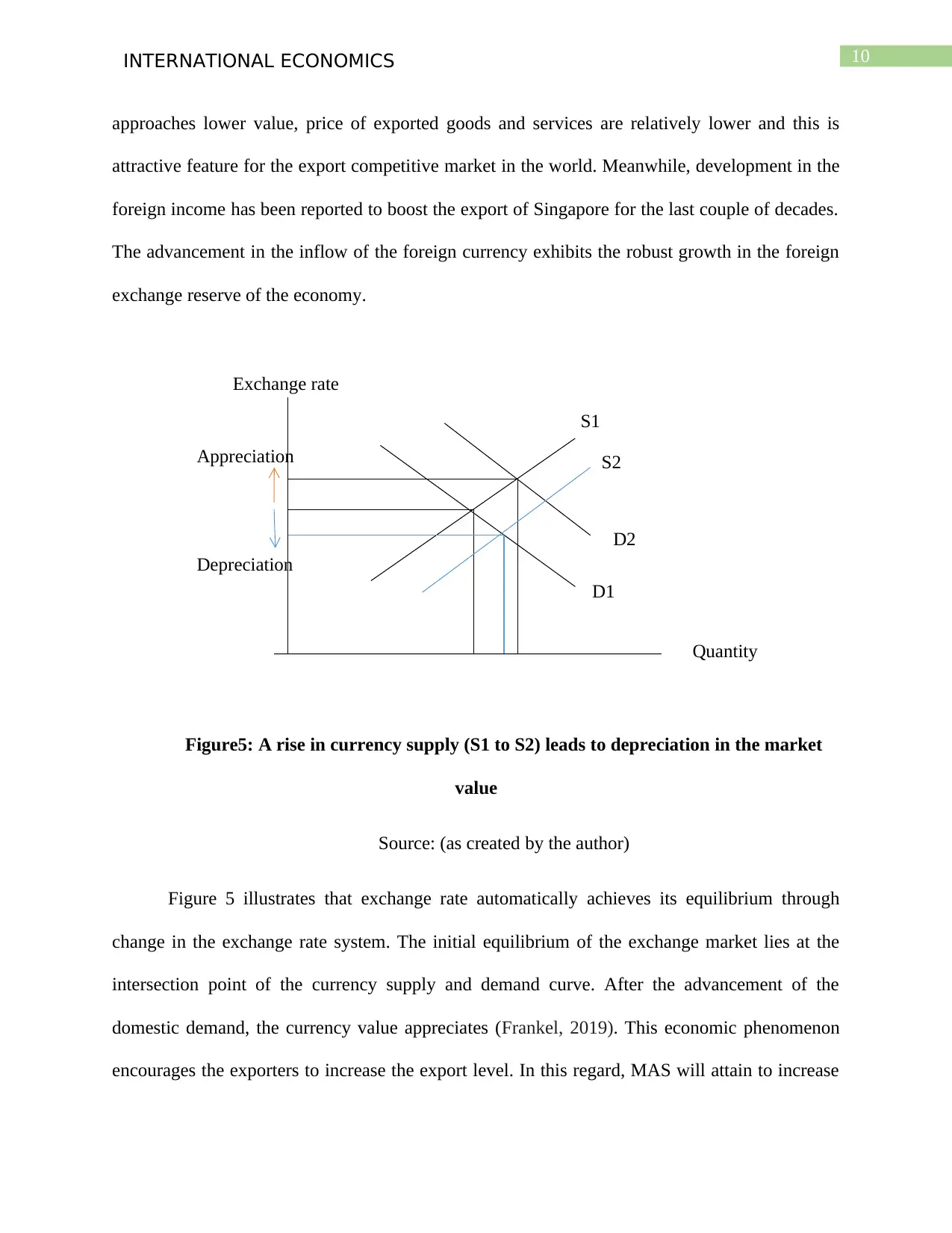
10INTERNATIONAL ECONOMICS
S1
S2
D2
D1
Quantity
Exchange rate
Appreciation
Depreciation
approaches lower value, price of exported goods and services are relatively lower and this is
attractive feature for the export competitive market in the world. Meanwhile, development in the
foreign income has been reported to boost the export of Singapore for the last couple of decades.
The advancement in the inflow of the foreign currency exhibits the robust growth in the foreign
exchange reserve of the economy.
Figure5: A rise in currency supply (S1 to S2) leads to depreciation in the market
value
Source: (as created by the author)
Figure 5 illustrates that exchange rate automatically achieves its equilibrium through
change in the exchange rate system. The initial equilibrium of the exchange market lies at the
intersection point of the currency supply and demand curve. After the advancement of the
domestic demand, the currency value appreciates (Frankel, 2019). This economic phenomenon
encourages the exporters to increase the export level. In this regard, MAS will attain to increase
S1
S2
D2
D1
Quantity
Exchange rate
Appreciation
Depreciation
approaches lower value, price of exported goods and services are relatively lower and this is
attractive feature for the export competitive market in the world. Meanwhile, development in the
foreign income has been reported to boost the export of Singapore for the last couple of decades.
The advancement in the inflow of the foreign currency exhibits the robust growth in the foreign
exchange reserve of the economy.
Figure5: A rise in currency supply (S1 to S2) leads to depreciation in the market
value
Source: (as created by the author)
Figure 5 illustrates that exchange rate automatically achieves its equilibrium through
change in the exchange rate system. The initial equilibrium of the exchange market lies at the
intersection point of the currency supply and demand curve. After the advancement of the
domestic demand, the currency value appreciates (Frankel, 2019). This economic phenomenon
encourages the exporters to increase the export level. In this regard, MAS will attain to increase
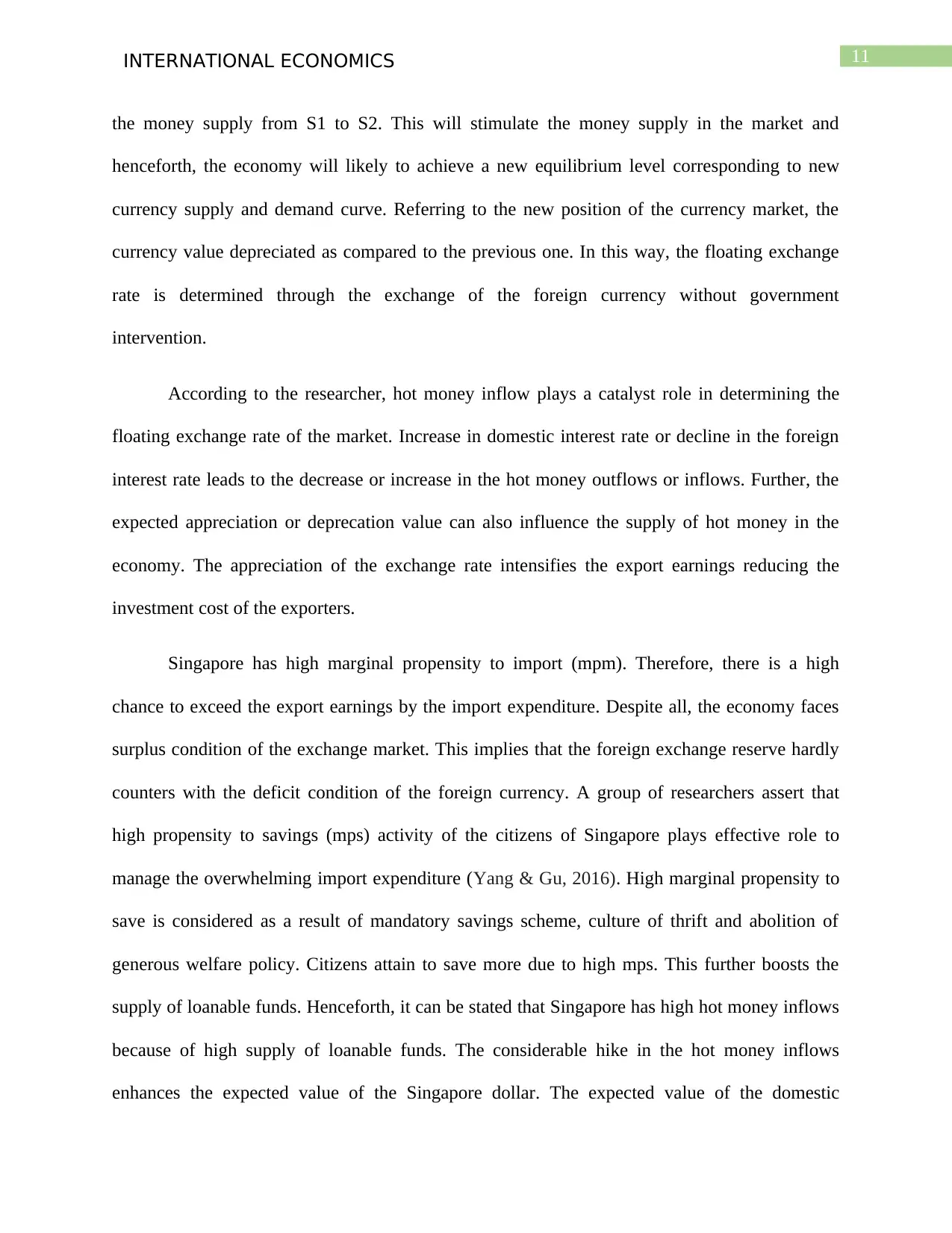
11INTERNATIONAL ECONOMICS
the money supply from S1 to S2. This will stimulate the money supply in the market and
henceforth, the economy will likely to achieve a new equilibrium level corresponding to new
currency supply and demand curve. Referring to the new position of the currency market, the
currency value depreciated as compared to the previous one. In this way, the floating exchange
rate is determined through the exchange of the foreign currency without government
intervention.
According to the researcher, hot money inflow plays a catalyst role in determining the
floating exchange rate of the market. Increase in domestic interest rate or decline in the foreign
interest rate leads to the decrease or increase in the hot money outflows or inflows. Further, the
expected appreciation or deprecation value can also influence the supply of hot money in the
economy. The appreciation of the exchange rate intensifies the export earnings reducing the
investment cost of the exporters.
Singapore has high marginal propensity to import (mpm). Therefore, there is a high
chance to exceed the export earnings by the import expenditure. Despite all, the economy faces
surplus condition of the exchange market. This implies that the foreign exchange reserve hardly
counters with the deficit condition of the foreign currency. A group of researchers assert that
high propensity to savings (mps) activity of the citizens of Singapore plays effective role to
manage the overwhelming import expenditure (Yang & Gu, 2016). High marginal propensity to
save is considered as a result of mandatory savings scheme, culture of thrift and abolition of
generous welfare policy. Citizens attain to save more due to high mps. This further boosts the
supply of loanable funds. Henceforth, it can be stated that Singapore has high hot money inflows
because of high supply of loanable funds. The considerable hike in the hot money inflows
enhances the expected value of the Singapore dollar. The expected value of the domestic
the money supply from S1 to S2. This will stimulate the money supply in the market and
henceforth, the economy will likely to achieve a new equilibrium level corresponding to new
currency supply and demand curve. Referring to the new position of the currency market, the
currency value depreciated as compared to the previous one. In this way, the floating exchange
rate is determined through the exchange of the foreign currency without government
intervention.
According to the researcher, hot money inflow plays a catalyst role in determining the
floating exchange rate of the market. Increase in domestic interest rate or decline in the foreign
interest rate leads to the decrease or increase in the hot money outflows or inflows. Further, the
expected appreciation or deprecation value can also influence the supply of hot money in the
economy. The appreciation of the exchange rate intensifies the export earnings reducing the
investment cost of the exporters.
Singapore has high marginal propensity to import (mpm). Therefore, there is a high
chance to exceed the export earnings by the import expenditure. Despite all, the economy faces
surplus condition of the exchange market. This implies that the foreign exchange reserve hardly
counters with the deficit condition of the foreign currency. A group of researchers assert that
high propensity to savings (mps) activity of the citizens of Singapore plays effective role to
manage the overwhelming import expenditure (Yang & Gu, 2016). High marginal propensity to
save is considered as a result of mandatory savings scheme, culture of thrift and abolition of
generous welfare policy. Citizens attain to save more due to high mps. This further boosts the
supply of loanable funds. Henceforth, it can be stated that Singapore has high hot money inflows
because of high supply of loanable funds. The considerable hike in the hot money inflows
enhances the expected value of the Singapore dollar. The expected value of the domestic
⊘ This is a preview!⊘
Do you want full access?
Subscribe today to unlock all pages.

Trusted by 1+ million students worldwide
1 out of 19
Related Documents
Your All-in-One AI-Powered Toolkit for Academic Success.
+13062052269
info@desklib.com
Available 24*7 on WhatsApp / Email
![[object Object]](/_next/static/media/star-bottom.7253800d.svg)
Unlock your academic potential
Copyright © 2020–2025 A2Z Services. All Rights Reserved. Developed and managed by ZUCOL.





